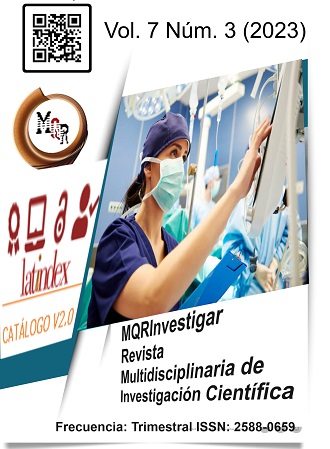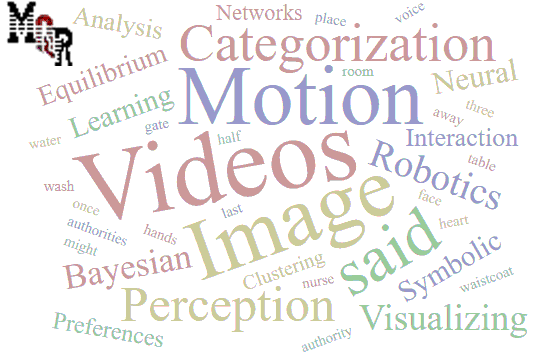Cirugía refractiva (CR) láser corneal, una comparación entre LASIK y PRK.
DOI:
https://doi.org/10.56048/MQR20225.7.3.2023.1030-1056Palabras clave:
ectasia corneal, cirugía refractiva, córnea, mitomicina CResumen
Antecedentes: La corrección de la visión con láser para los errores de refracción incluye dos procedimientos principales: queratomileusis in situ con láser (LASIK) y tratamiento de superficies. La queratectomía fotorrefractiva (PRK) fue el primer tratamiento de superficie introducido desde finales de la década de 1980. En este procedimiento de fotoablación, el haz ultravioleta generado por un láser excimer de fluoruro de argón de 193 nm se irradia al estroma corneal, después de la extirpación epitelial, para remodelar el estroma corneal anterior para corregir la ametropía.
Objetivo: Comparar la técnica LASIK VS la PRK, respecto de la cirugía refractiva (CR) láser corneal.
Metodología: Se realizo una revisión bibliográfica tipo narrativa, efectuando búsquedas en diferentes bases científica de datos como SpringerLink, PubMed, Dialnet, Scopus, Sciencedirect, Scielo, Medline. Para las palabras clave o términos de búsqueda, fueron términos los Descriptores en Ciencias de Salud (DeCS)/(MeSH), y, además del empleó de operadores Booleanos como “AND” y “OR”. Tras el criterio de elegibilidad, 15 artículos se analizaron y se incluyeron en el análisis de esta revisión.
Resultados: De los 15 artículos empleados, y en base a los objetivos, se obtiene como resultado que, tanto LASIK como PRK, son procedimientos seguros y eficaces, por la pronta recuperación visual, buenos resultados refractivos, y postoperatorio con mínima incomodidad. La aplicación mitomicina C ayuda a reducir el riesgo de neblina corneal, de manera similar entre las dos técnicas. En cuanto a complicaciones, se halló ectasia corneal, estrías, pliegues, dislocación del flap, depósitos en la interfase, infección, queratitis lamelar difusa, entre otras.
Conclusiones: La cirugía laser (CR) es un procedimiento seguro y eficaz, en cualquiera de las técnicas aplicadas. Lo que ha ayudado a mejorar los resultados de estas técnicas, es la aplicación de la MMC que, tanto en LASIK y PRK, ayudan a una mejor previsibilidad y reduce significativamente la neblina corneal, como la complicación más común; en cuanto a ello, la ectasia corneal, el ojo seco y las queratitis, que, aunque son poco comunes, el conocimiento profundo de las complicaciones puede ayudar a reducir su aparición, y la identificación temprana con el tratamiento adecuado a tiempo puede salvar estos ojos de la pérdida de visión.
Descargas
Métricas
Cited
DOI: 10.56048![]()
Citas
Wang Y, Guo Y, Li Y, Zhang Y, yuan Y, Wu T, et al. The impact of different corneal refractive surgeries on binocular dynamic visual acuity. Front Neurosci. 2023; 17:1142339.
Miraftab M, Hashemi H, Aghamirsalim M, Fayyaz S, Asgari S. Matched comparison of corneal higher order aberrations induced by SMILE to femtosecond assisted LASIK and to PRK in correcting moderate and high myopia: 3.00mm vs. 6.00mm. BMC Ophthalmol. 2021;21(1):216.
Moshirfar M, Tukan AN, Bundogji N, Liu HY, McCabe SE, Ronquillo YC, et al. Ectasia After Corneal Refractive Surgery: A Systematic Review. Ophthalmol Ther. 1 2021;10(4):753-76.
Cennamo G, Menna F, Sinisi F, Cennamo G, Breve MA, Napolitano P, et al. Twenty-Year Follow-Up of Excimer Laser Photorefractive Keratectomy: A Retrospective Observational Study. Ophthalmol Ther. 2020;9(4):917-27.
Chang JY, Lin PY, Hsu CC, Liu CJL. Comparison of clinical outcomes of LASIK, Trans-PRK, and SMILE for correction of myopia. Journal of the Chinese Medical Association. 2022;85(2):145.
Tang Y, Chen A, Zou M, Liu Z, Young CA, Zheng D, et al. Prevalence and time trends of refractive error in Chinese children: A systematic review and meta-analysis. J Glob Health. 2021; 11:08006.
Wolffsohn JS, Jong M, Smith EL, Resnikoff SR, Jonas JB, Logan NS, et al. IMI 2021 Reports and Digest – Reflections on the Implications for Clinical Practice. Invest Ophthalmol Vis Sci. 2021;62(5):1.
Rey-Rodriguez DV, Moreno-Montoya J, Álvarez-Peregrina C. Prevalence of Myopia in America: A Systematic Review and Meta-Analysis. Cienc Tecnol Salud Vis Ocul. 2021;19(1):49-58.
Anangonó G, González K. Prevalencia de defectos refractarios en los alumnos de la Unidad Educativa Lev Vygotsky en el periodo 2019-2020 [Tesis de Grado]. [Quito, Ecuador]: Universidad Central del Ecuador. Facultad de Ciencias Médicas; 2022.
Ang M, Gatinel D, Reinstein DZ, Mertens E, Alió del Barrio JL, Alió JL. Refractive surgery beyond 2020. Eye (Lond).2021;35(2):362-82.
Roberto B. From lasik to smile: Time to change laser refractive surgery. J Clin Res Ophthalmol. 2021;007-11.
Benjamin F. Boyd. Atlas de Cirugía Refractiva. Highlights of Ophthalmology; 2018. 231 p.
Hashemi H, Fotouhi A, Yekta A, Pakzad R, Ostadimoghaddam H, Khabazkhoob M. Global and regional estimates of prevalence of refractive errors: Systematic review and meta-analysis. Journal of Current Ophthalmology. 2019;30(1):3-22.
Li HY, Ye Z, Li ZH. Postoperative efficacy, safety, predictability, and visual quality of implantable collamer lens implantation versus small incision lenticule extraction in myopic eyes: a Meta-analysis. International Journal of Ophthalmology. 2022;16(3):442-52.
Fraga-Graells E, Álvarez-Peregrina C, Villa-Collar C, Sánchez-Tena MÁ. Ojo seco y cirugía refractiva, estudio de red de citación. Revista Mexicana de Oftalmología [Internet]. 202;95(6). Disponible en: https://www.rmo.com.mx/frame_esp.php?id=278
Dołowiec-Kwapisz A, Misiuk-Hojło M, Piotrowska H. Cataract Surgery after Radial Keratotomy with Non-Diffractive Extended Depth of Focus Lens Implantation. Medicina. 2022;58(5):689.
Rocha-de-Lossada C, Rodríguez-Vallejo M, Rodríguez-Calvo-de-Mora M, Ribeiro FJ, Fernández J. Managing low corneal astigmatism in patients with presbyopia correcting intraocular lenses: a narrative review. BMC Ophthalmology. 2023;23(1):254.
Bai G, Li X, Zhang S, Wang Q, Liu G. Analysis of visual quality after multifocal intraocular lens implantation in post-LASIK cataract patients. Heliyon [Internet]. 1 de mayo de 2023;9(5). Disponible en: https://www.cell.com/heliyon/abstract/S2405-8440(23)02927-4
Mukazhanova A, Aldasheva N, Iskakbayeva J, Bakhytbek R, Ualiyeva A, Baigonova K, et al. Prevalence of refractive errors and risk factors for myopia among schoolchildren of Almaty, Kazakhstan: A cross-sectional study. Nagra M, editor. PLoS ONE. 2022;17(6):e0269474.
Tananuvat N, Winaikosol P, Niparugs M, Chaidaroon W, Tangmonkongvoragul C, Ausayakhun S. Twelve-Month Outcomes of the Wavefront-Optimized Photorefractive Keratectomy for High Myopic Correction Compared with Low-to-Moderate Myopia. OPTH. 2021; Volume 15:4775-85.
Zhang J, Wu Y, Sharma B, Gupta R, Jawla S, Bullimore MA. Epidemiology and Burden of Astigmatism: A Systematic Literature Review. Optom Vis Sci. 2023;100(3):218-31.
Delbarre M, Le HM, Boucenna W, Froussart-Maille F. [Refractive surgery for hyperopia]. J Fr Ophtalmol. 2021;44(5):723-9.
Piao J, Li Y. Comparative Evaluation of the Visual and Refractive Outcomes Following SMILE, FS-LASIK, and T-PRK Surgery: A Retrospective, Non-Blinded Clinical Study [Internet]. In Review; 2021. Disponible en: https://www.researchsquare.com/article/rs-257979/v1
Dimitri T. Azar. Cirugía refractiva. [Internet]. Tercera. Elsevier; 2020. 560 p. Disponible en: https://edimeinter.com/catalogo/novedad/cirugia-refractiva-3a-edicion-2020/
Taneri S, Knepper J, Rost A, Dick HB. PRK, LASIK, SMILE im Langzeitverlauf. Ophthalmologe.2022;119(2):163-9.
Bonzano C, Cutolo CA, Musetti D, Di Mola I, Pizzorno C, Scotto R, et al. Delayed Re-epithelialization After Epithelium-Off Crosslinking: Predictors and Impact on Keratoconus Progression. Front Med (Lausanne). 2021; 8:657993.
Shah R. History and Results; Indications and Contraindications of SMILE, Compared With LASIK. The Asia-Pacific Journal of Ophthalmology. 2019;8(5):371.
Lim L, Lim EWL. A Review of Corneal Collagen Cross-linking – Current Trends in Practice Applications. TOOPHTJ. 2019;12(1):181-213.
Lim EWL, Lim L. Review of Laser Vision Correction (LASIK, PRK and SMILE) with Simultaneous Accelerated Corneal Crosslinking – Long-term Results. Current Eye Research. 2019;44(11):1171-80.
Schuh A, Kolb CM, Mayer WJ, Vounotrypidis E, Kreutzer T, Kohnen T, et al. Comparison of changes in corneal volume and corneal thickness after myopia correction between LASIK and SMILE. Mohan RR, editor. PLoS ONE.2021;16(5): e0250700.
Sahay P, Bafna RK, Reddy JC, Vajpayee RB, Sharma N. Complications of laser-assisted in situ keratomileusis. Indian Journal of Ophthalmology. 2021;69(7):1658.
de Ortueta D, von Rüden D, Arba-Mosquera S. Refractive Effect of Epithelial Remodelling in Myopia after Transepithelial Photorefractive Keratectomy. Vision. 2022;6(4):74.
Guo H, Hosseini-Moghaddam SM, Hodge W. Corneal biomechanical properties after SMILE versus FLEX, LASIK, LASEK, or PRK: a systematic review and meta-analysis. BMC Ophthalmol.;19(1):167.
Ouerdane Y, Zaazouee MS, Mohamed MEA, Hasan MT, Hamdy M, Ghoneim AM, et al. Mitomycin C application after photorefractive keratectomy in high, moderate, or low myopia: Systematic review and meta-analysis. Indian J Ophthalmol. 2021;69(12):3421-31.
Moawad EM, Elghany AAA, Gab-Alla AA, Elbassiouny OM, Badawy MS. LASIK-induced corneal changes after correction of hyperopia with and without application of Mitomycin-C. BMC Ophthalmology [Internet]. 2019;19. Disponible en: https://www.ncbi.nlm.nih.gov/pmc/articles/PMC6480872/
Arranz-Marquez E, Katsanos A, Kozobolis VP, Konstas AGP, Teus MA. A Critical Overview of the Biological Effects of Mitomycin C Application on the Cornea Following Refractive Surgery. Adv Ther. 2019;36(4):786-97.
de Oliveira RC, Wilson SE. Biological effects of Mitomycin C on late corneal haze stromal fibrosis following PRK. Exp Eye Res. 2020; 200:108218.
Ong HS, Farook M, Tan BBC, Williams GP, Santhiago MR, Mehta JS. Corneal Ectasia Risk and Percentage Tissue Altered In Myopic Patients Presenting For Refractive Surgery. Clin Ophthalmol. 2019; 13:2003-15.
Das S, Garg P, Mullick R, Annavajjhala S. Keratitis following laser refractive surgery: Clinical spectrum, prevention and management. Indian J Ophthalmol. 2020;68(12):2813-8.
Gomel N, Negari S, Frucht-Pery J, Wajnsztajn D, Strassman E, Solomon A. Predictive factors for efficacy and safety in refractive surgery for myopia. González-Méijome JM, editor. PLoS ONE. 2018;13(12):e0208608.
Kobashi H, Kamiya K, Igarashi A, Takahashi M, Shimizu K. Two-years results of small-incision lenticule extraction and wavefront-guided laser in situ keratomileusis for Myopia. Acta Ophthalmol. 2019;96(2): e119-26.
Chang JY, Lin PY, Hsu CC, Liu CJL. Comparison of clinical outcomes of LASIK, Trans-PRK, and SMILE for correction of myopia. Journal of the Chinese Medical Association. 2022;85(2):145-51.
Avalos-Lara SJ, Pacheco-del Valle C, Baca-Lozada O, Alegría-Gómez ED, Fernández-Vizcaya O, Velasco-Ramos R. Incidencia de complicaciones de la cirugía de extracción del lentículo por incisión pequeña (SMILE). RMO. 2020;94(2):3563.
Schallhorn JM, Schallhorn SC, Teenan D, Hannan SJ, Pelouskova M, Venter JA. Incidence of Intraoperative and Early Postoperative Adverse Events in a Large Cohort of Consecutive Refractive Lens Exchange Procedures. American Journal of Ophthalmology. 2019; 208:406-14.
Tucker SH, Emory Eye Center, Atlanta, GA, USA, Sood P, Emory University Hospital Midtown, Atlanta, GA, USA. Flap Complications from Femtosecond Laser-assisted in Situ Keratomileusis. US Ophthalmic Review. 2019;12(1):21.
Publicado
Cómo citar
Número
Sección
Licencia
Derechos de autor 2023 MQRInvestigar

Esta obra está bajo una licencia internacional Creative Commons Atribución 4.0.
Los autores se comprometen a respetar la información académica de otros autores, y a ceder los derechos de autor a la Revista MQRInvestigar, para que el artículo pueda ser editado, publicado y distribuido. El contenido de los artículos científicos y de las publicaciones que aparecen en la revista es responsabilidad exclusiva de sus autores. La distribución de los artículos publicados se realiza bajo una licencia 



































